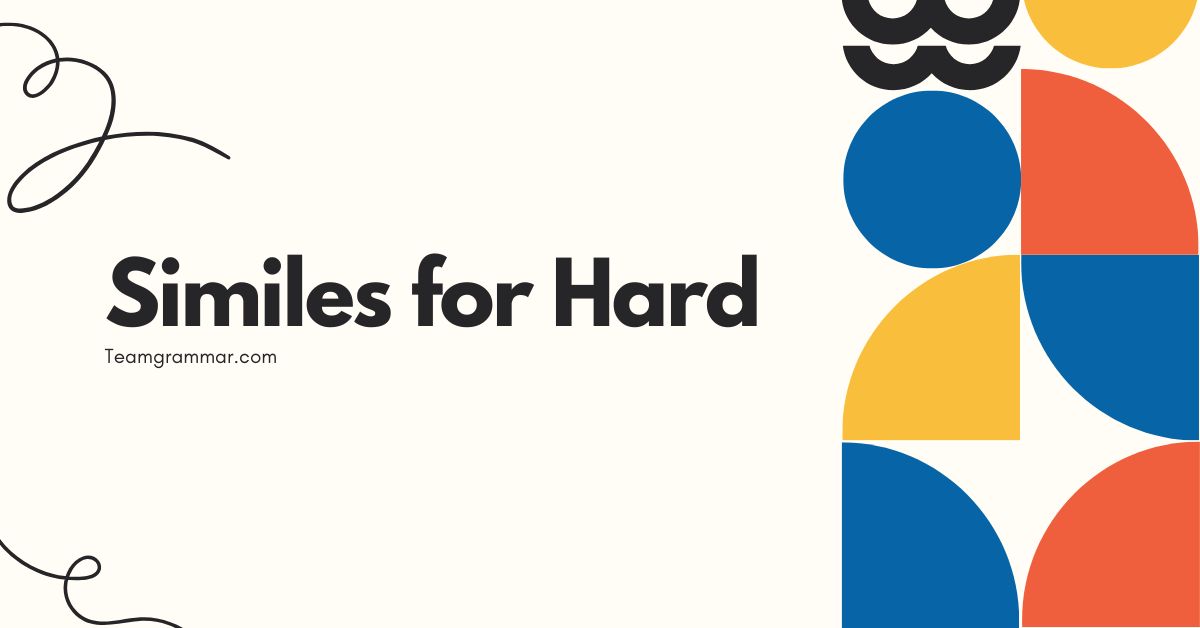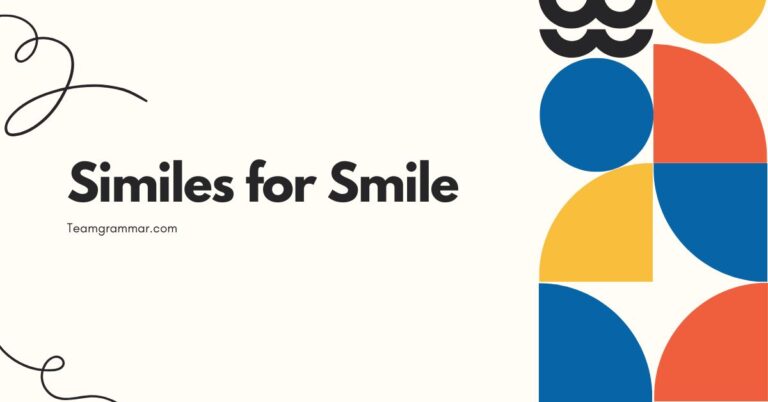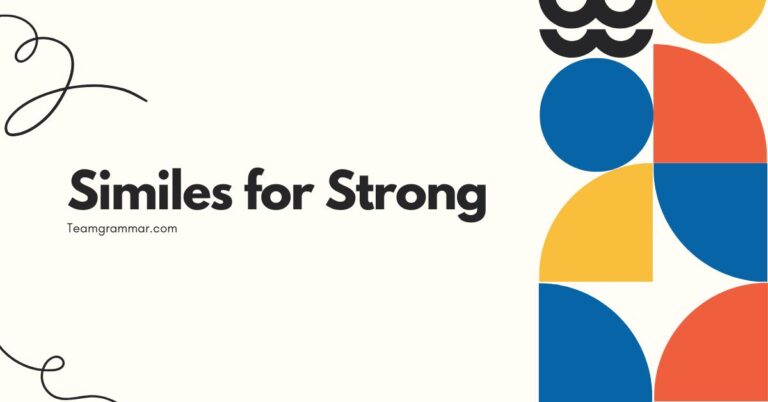41 Similes for Hard: Mastering Figurative Language
Understanding similes is crucial for enhancing your writing and comprehension skills. Similes, a type of figurative language, allow you to create vivid comparisons that make your writing more engaging and descriptive.
This article provides a comprehensive guide to similes for the word “hard,” exploring their various forms, usage, and impact. Whether you’re a student, writer, or English language learner, this guide will equip you with the knowledge and tools to effectively use similes in your communication.
This article will benefit anyone looking to enrich their vocabulary and improve their writing style. We will cover everything from basic definitions to advanced applications, ensuring a thorough grasp of the topic.
With numerous examples, practice exercises, and detailed explanations, you’ll be well-prepared to incorporate similes for “hard” into your everyday language.
Table of Contents
- Definition of Simile
- Structural Breakdown of Similes
- Types of Similes for “Hard”
- Examples of Similes for “Hard”
- Usage Rules for Similes
- Common Mistakes with Similes
- Practice Exercises
- Advanced Topics in Similes
- Frequently Asked Questions
- Conclusion
Definition of Simile
Asimileis a figure of speech that compares two unlike things using the words “like” or “as.” The primary function of a simile is to create a vivid image or emphasize a particular quality by drawing a comparison to something familiar. Similes are essential tools for writers and speakers who want to add depth and color to their language.
They help to convey abstract concepts in a more concrete and relatable way.
In the context of the word “hard,” similes can be used to describe physical hardness, emotional difficulty, or the intensity of an action. The effectiveness of a simile lies in its ability to evoke a clear and memorable image in the mind of the reader or listener.
Understanding how to construct and use similes effectively is a key skill in mastering the English language.
Similes are classified as a type of figurative language, which also includes metaphors, personification, and hyperbole. While metaphors directly equate two things (e.g., “He is a rock”), similes make a comparison (e.g., “He is as hard as a rock”).
The distinction is subtle but important. Similes provide a more nuanced and less assertive comparison, allowing for a greater range of expression.
Structural Breakdown of Similes
The basic structure of a simile consists of three main components: thesubject, thelinking word(either “like” or “as”), and theobject of comparison. The subject is the thing being described, and the object of comparison is what it is being compared to.
The linking word establishes the relationship between the two.
For example, in the simile “His heart was as hard as stone,” “his heart” is the subject, “as” is the linking word, and “stone” is the object of comparison. This structure is consistent across all similes, although the complexity of the subject and object can vary.
A deep understanding of this structure allows for the creation of clear and effective similes.
The structure can also be expanded to include modifying words or phrases that add detail to the comparison. For instance, “The task was as hard as climbing Mount Everest in winter” includes additional information that enhances the vividness and impact of the simile.
The key is to maintain clarity and ensure that the comparison remains logical and meaningful.
Types of Similes for “Hard”
Similes for “hard” can be categorized based on the aspect of hardness they emphasize. These categories include physical hardness, emotional hardness, and difficulty.
Each type serves a different purpose and can be used in various contexts to create specific effects.
Physical Hardness
These similes describe the literal hardness of an object or substance. They often involve comparisons to materials known for their rigidity and resistance.
Examples include “as hard as a rock,” “as hard as steel,” and “as hard as diamonds.” These similes are commonly used in descriptive writing to convey the tangible qualities of something.
Emotional Hardness
Emotional hardness refers to a lack of empathy, compassion, or sensitivity. Similes in this category often compare a person’s emotional state to something unyielding or impenetrable.
Examples include “as hard as ice,” “as hard as nails,” and “as hard as a stone heart.” These similes are frequently used to describe characters in literature or to express feelings of emotional distance.
Difficulty
These similes describe the level of difficulty or challenge associated with a task or situation. They often involve comparisons to arduous or insurmountable obstacles.
Examples include “as hard as pulling teeth,” “as hard as walking through treacle,” and “as hard as solving a Rubik’s Cube blindfolded.” These similes are useful for emphasizing the magnitude of a challenge or the effort required to overcome it.
Examples of Similes for “Hard”
Here are some examples of similes for “hard,” categorized for clarity. Each table contains a variety of similes designed to illustrate different aspects of hardness, from physical to emotional and challenging situations.
Similes Describing Physical Hardness
The following table provides examples of similes used to describe physical hardness. These similes often compare objects or substances to materials known for their strength and rigidity, such as rocks, steel, and diamonds.
| Simile | Context |
|---|---|
| As hard as a rock | The ground was as hard as a rock after the drought. |
| As hard as steel | The metal casing was as hard as steel, protecting the delicate machinery inside. |
| As hard as diamonds | The drill bit was as hard as diamonds, capable of cutting through the toughest materials. |
| As hard as concrete | The newly laid pavement was as hard as concrete, ready to bear heavy loads. |
| As hard as granite | The countertop was as hard as granite, resistant to scratches and stains. |
| As hard as iron | His grip was as hard as iron, leaving no room for escape. |
| As hard as bone | The fossilized remains were as hard as bone, preserved for millions of years. |
| As hard as dried clay | The soil was as hard as dried clay, making it difficult to plant anything. |
| As hard as a brick | The old bread was as hard as a brick, nearly impossible to cut. |
| As hard as marble | The statue was as hard as marble, radiating strength and permanence. |
| As hard as flint | The stone was as hard as flint, perfect for striking a spark. |
| As hard as a boulder | The obstacle in their path was as hard as a boulder, seemingly immovable. |
| As hard as armor | The knight’s armor was as hard as armor, protecting him from harm. |
| As hard as ceramic | The tiles were as hard as ceramic, durable and easy to clean. |
| As hard as petrified wood | The ancient artifact was as hard as petrified wood, a testament to time. |
| As hard as obsidian | The volcanic glass was as hard as obsidian, with a razor-sharp edge. |
| As hard as a rock face | The cliff was as hard as a rock face, challenging even the most experienced climbers. |
| As hard as tempered glass | The screen protector was as hard as tempered glass, safeguarding the phone from scratches. |
| As hard as a frozen lake | The ice on the lake was as hard as a frozen lake, perfect for skating. |
| As hard as seasoned timber | The wood was as hard as seasoned timber, ideal for building sturdy structures. |
| As hard as a walnut shell | The outer casing of the device was as hard as a walnut shell, protecting the delicate components inside. |
| As hard as a metal safe | The security door was as hard as a metal safe, ensuring complete protection for the valuables within. |
Similes Describing Emotional Hardness
The table below illustrates similes used to describe emotional hardness. These similes often compare a person’s emotional state to something cold, unyielding, or impenetrable, such as ice, stone, or nails.
| Simile | Context |
|---|---|
| As hard as ice | Her heart was as hard as ice after years of betrayal. |
| As hard as nails | The boss was as hard as nails, demanding perfection from everyone. |
| As hard as a stone heart | He had a stone heart, incapable of feeling empathy for others. |
| As hard as a wall | She put up a wall around her emotions, making her as hard as a wall to reach. |
| As hard as granite | His resolve was as hard as granite, unyielding in the face of adversity. |
| As hard as steel | Her gaze was as hard as steel, intimidating anyone who dared to challenge her. |
| As hard as a clenched fist | His anger made him as hard as a clenched fist, ready to lash out. |
| As hard as a judge’s gavel | The judge’s decision was as hard as a judge’s gavel, final and unyielding. |
| As hard as a prison cell | Her loneliness felt as hard as a prison cell, isolating her from the world. |
| As hard as a winter storm | His criticism was as hard as a winter storm, leaving her feeling battered and cold. |
| As hard as a soldier’s stare | The veteran’s stare was as hard as a soldier’s stare, reflecting years of hardship. |
| As hard as a miser’s heart | The old man’s heart was as hard as a miser’s heart, unwilling to share his wealth. |
| As hard as a fortress wall | Her defenses were as hard as a fortress wall, protecting her from vulnerability. |
| As hard as a statue’s gaze | The statue’s gaze was as hard as a statue’s gaze, cold and unfeeling. |
| As hard as a robot’s programming | His responses were as hard as a robot’s programming, devoid of emotion. |
| As hard as a diamond cutter | Her judgment was as hard as a diamond cutter, precise and unforgiving. |
| As hard as a Spartan warrior | His discipline was as hard as a Spartan warrior, unwavering and relentless. |
| As hard as a frozen tundra | Her spirit was as hard as a frozen tundra, barren and unforgiving. |
| As hard as a clenched jaw | His determination was as hard as a clenched jaw, signaling his refusal to give up. |
| As hard as a stone gargoyle | His expression was as hard as a stone gargoyle, ominous and unreadable. |
Similes Describing Difficulty
The following table presents similes used to describe the level of difficulty or challenge associated with a task or situation. These similes often compare the task to arduous or seemingly insurmountable obstacles.
| Simile | Context |
|---|---|
| As hard as pulling teeth | Getting him to agree was as hard as pulling teeth. |
| As hard as walking through treacle | The project felt as hard as walking through treacle, slow and exhausting. |
| As hard as solving a Rubik’s Cube blindfolded | The puzzle was as hard as solving a Rubik’s Cube blindfolded. |
| As hard as climbing Mount Everest | The task was as hard as climbing Mount Everest, requiring immense effort. |
| As hard as finding a needle in a haystack | The search was as hard as finding a needle in a haystack. |
| As hard as herding cats | Managing the team was as hard as herding cats, chaotic and unpredictable. |
| As hard as splitting atoms | Understanding the theory was as hard as splitting atoms. |
| As hard as teaching an old dog new tricks | Changing his habits was as hard as teaching an old dog new tricks. |
| As hard as nailing jelly to a tree | Trying to define the concept was as hard as nailing jelly to a tree. |
| As hard as getting blood from a stone | Getting information from him was as hard as getting blood from a stone. |
| As hard as deciphering hieroglyphics | Reading the ancient text was as hard as deciphering hieroglyphics. |
| As hard as catching smoke | Trying to hold onto the fleeting moment was as hard as catching smoke. |
| As hard as building a house with no tools | Completing the project with limited resources was as hard as building a house with no tools. |
| As hard as finding water in the desert | Discovering a solution seemed as hard as finding water in the desert. |
| As hard as moving mountains | Changing his mind was as hard as moving mountains. |
| As hard as untangling a spiderweb | Sorting through the complex data was as hard as untangling a spiderweb. |
| As hard as flying to the moon | Achieving their ambitious goals seemed as hard as flying to the moon. |
| As hard as stopping a runaway train | Controlling the situation was as hard as stopping a runaway train. |
| As hard as counting grains of sand | Estimating the total cost was as hard as counting grains of sand. |
| As hard as reversing a waterfall | Changing the course of events was as hard as reversing a waterfall. |
Usage Rules for Similes
Using similes effectively involves following certain rules to ensure clarity and impact. The primary rule is that the comparison should be logical and understandable.
The two things being compared should share a common attribute that is relevant to the context.
Another important rule is to avoid clichés. Overused similes, such as “as hard as a rock,” can lose their impact and make your writing seem unoriginal.
Strive to create fresh and imaginative comparisons that will capture the reader’s attention.
Additionally, consider the tone and audience when choosing a simile. A simile that is appropriate in one context may be inappropriate in another.
For example, a humorous simile may be suitable for informal writing but not for a formal academic paper.
Common Mistakes with Similes
One common mistake is using similes that are illogical or unclear. For example, saying “The sky was as hard as a banana” makes no sense because there is no clear connection between the sky and a banana in terms of hardness.
Another mistake is confusing similes with metaphors. Remember that similes use “like” or “as” to make a comparison, while metaphors directly equate two things.
For example, “He is as hard as a rock” is a simile, while “He is a rock” is a metaphor.
Overusing similes is also a common pitfall. While similes can enhance your writing, too many can make it seem cluttered and distracting.
Use them sparingly and strategically to achieve the greatest impact.
Here’s a table illustrating common mistakes with similes, along with corrections:
| Incorrect | Correct | Explanation |
|---|---|---|
| The sky was as hard as a banana. | The sky was as hard as slate. | The comparison must be logical. |
| He is a rock. | He is as hard as a rock. | Distinguish between metaphor and simile. |
| The task was hard, like a challenge, as hard as a test, like an ordeal. | The task was as hard as scaling a mountain. | Avoid overuse and redundancy. |
Practice Exercises
Test your understanding of similes with these practice exercises. Choose the best simile to complete each sentence, or create your own.
Exercise 1: Fill in the Blanks
Complete the following sentences with an appropriate simile using “hard.”
- His determination was ____________________.
- The ice was ____________________.
- The task proved to be ____________________.
- Her expression was ____________________.
- The ground was ____________________.
- The metal was ____________________.
- The bread had become ____________________.
- His grip felt ____________________.
- The puzzle was ____________________.
- The climb was ____________________.
Answer Key:
- His determination was as hard as steel.
- The ice was as hard as a rock.
- The task proved to be as hard as pulling teeth.
- Her expression was as hard as ice.
- The ground was as hard as concrete.
- The metal was as hard as diamonds.
- The bread had become as hard as a brick.
- His grip felt as hard as iron.
- The puzzle was as hard as solving a Rubik’s Cube blindfolded.
- The climb was as hard as climbing Mount Everest.
Exercise 2: Create Your Own Similes
Write a simile for each of the following scenarios, using the word “hard.”
- Describing a difficult decision.
- Describing a challenging workout.
- Describing a person with a stern demeanor.
- Describing a tough material.
- Describing a complex problem.
- Describing an unyielding stance.
- Describing a frozen surface.
- Describing a demanding boss.
- Describing a complicated relationship.
- Describing an arduous journey.
Sample Answers:
- Making the decision was as hard as navigating a minefield.
- The workout was as hard as running a marathon uphill.
- The person’s demeanor was as hard as a judge’s gavel.
- The material was as hard as tempered steel.
- The problem was as hard as untangling a Gordian knot.
- Their stance was as hard as a fortress wall.
- The frozen surface was as hard as a sheet of glass.
- The boss was as hard as nails.
- The relationship was as hard as walking a tightrope.
- The journey was as hard as crossing a desert on foot.
Advanced Topics in Similes
For advanced learners, exploring the nuances of similes can lead to more sophisticated writing. One advanced topic is the use ofextended similes, which involve developing a comparison over multiple sentences or paragraphs.
This technique allows for a more detailed and nuanced exploration of the subject.
Another advanced topic is the use ofironic similes, where the comparison is deliberately incongruous or contradictory. This can be used to create humor or to satirize a particular subject.
Understanding how to use similes in these more complex ways can elevate your writing to a higher level.
Furthermore, studying the use of similes in different literary periods and genres can provide valuable insights into their historical and cultural significance. Analyzing how famous writers have employed similes can inspire you to develop your own unique style.
Frequently Asked Questions
- What is the difference between a simile and a metaphor?
A simile compares two things using “like” or “as,” while a metaphor directly equates two things. For example, “He is as hard as a rock” (simile) versus “He is a rock” (metaphor). Similes are less assertive and more nuanced.
- Why are similes important in writing?
Similes add vividness, clarity, and depth to writing. They help readers visualize and understand abstract concepts by relating them to something familiar and concrete. Effective similes can make your writing more engaging and memorable.
- How can I avoid using clichés in my similes?
To avoid clichés, strive to create original and imaginative comparisons. Think beyond the obvious and consider unique attributes that connect the two things you are comparing. Brainstorm a list of potential comparisons before settling on one.
- Can I use similes in formal writing?
Yes, but use them judiciously. Similes can be effective in formal writing to clarify complex ideas or to add a touch of stylistic flair. However, avoid overly informal or humorous similes that may be inappropriate for the context.
- What are some common mistakes to avoid when using similes?
Common mistakes include using illogical comparisons, confusing similes with metaphors, and overusing similes. Ensure that your comparisons are clear, relevant, and not overly repetitive.
- How do I choose the right simile for a particular situation?
Consider the context, tone, and audience. Choose a simile that is appropriate for the situation and that effectively conveys the intended meaning. Think about the specific attribute you want to emphasize and select a comparison that highlights that attribute.
- Are there any rules about the length of a simile?
There are no strict rules, but similes should be concise and focused. Avoid overly long or convoluted comparisons that may confuse the reader. Aim for clarity and brevity.
- How can I improve my ability to create effective similes?
Practice regularly, read widely, and pay attention to how other writers use similes. Experiment with different comparisons and ask for feedback on your writing. Over time, you will develop a stronger sense of what works and what doesn’t.
- What is an extended simile, and how is it used?
An extended simile is a simile that is developed over several sentences or even a paragraph. It allows for a more detailed and nuanced comparison, providing a richer and more vivid description. This technique is often used in literature to create a more profound impact on the reader.
- How can I use similes to create a specific tone in my writing?
The choice of simile can significantly impact the tone of your writing. For example, using a lighthearted or humorous simile can create a playful tone, while using a serious or dramatic simile can create a more somber tone. Consider the connotations of the comparison you are making and how it will affect the overall mood of your piece.
Conclusion
Mastering the use of similes, especially those related to the concept of “hard,” can greatly enhance your writing and communication skills. By understanding the structure, types, and usage rules of similes, you can create more vivid and impactful descriptions.
Remember to avoid clichés, use comparisons logically, and consider your audience and tone.
Continue to practice creating and identifying similes in various contexts. The more you engage with this figure of speech, the more confident and skilled you will become in using it effectively.
Explore different literary works and analyze how authors use similes to enhance their storytelling. With dedication and practice, you can master the art of using similes to bring your writing to life.
By incorporating these techniques and guidelines, you’ll be well-equipped to use similes for “hard” and other concepts to enrich your writing and express yourself with greater clarity and creativity. Keep experimenting and exploring the possibilities that figurative language offers!







